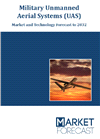Carderock's McAllister Talks Future of Unmanned Vehicles
May 29, 2019
-Before the turn of the century, futurists imagined today looking something like an episode of “The Jetsons,” with robots doing the dull and dirty work in every home, and pilotless flying cars providing seamless transportation. While that is certainly not the case yet, futuristic concepts are being developed and tested at Naval Surface Warfare Center, Carderock Division.
Reid McAllister is the director of Carderock’s Integrated Unmanned Maritime Mobility Systems, which is responsible for the research, development, test and evaluation of unmanned maritime systems and enabling technologies. McAllister said he knew years ago that unmanned systems would be a big part of future warfare, and he began coordination efforts to establish an unmanned systems community of interest across the Navy's Warfare Centers, laboratories, System Commands, academia and industry.
In 2015, Carderock Division and Naval Undersea Warfare Center, Newport Division started the Unmanned Vehicles and Autonomous Systems (UVAS) Working Group, co-led by McAllister and Newport’s Chris Egan, with the idea to create a thriving, high-velocity learning enterprise to collaboratively exploit the Warfare Centers’ collective technical capabilities and ensure the Navy has the most reliable and cost-effective unmanned systems.
“The focus of the UVAS Working Group is not just about developing unmanned systems technology alone,” said McAllister. “It’s also about integrating unmanned systems and related technologies into the naval force to achieve force-multiplying capability through dynamic man-machine teaming.”
According to McAllister, the future of unmanned systems success hinges on the ability to rapidly advance autonomy development and the speed at which the Navy can safely transition those advancements to the fleet.
Unmanned systems that are 100 percent autonomous need to have the ability to function on their own when communications with the remote operator are lost. Different types of maritime platforms have distinct communication limitations and those variables have to be accounted for. Undersea systems cannot use radio frequencies for routine communications when submerged, while surface platforms can communicate as long as over-the-horizon links are maintained. When unmanned systems go into hostile environments, they must have the ability to continue with the mission.
Reliance on autonomy becomes critical to system adaptability and mission success. If a system’s autonomy/sensor fusion is smart enough to be able to perceive the dynamic world it is operating in and react accordingly, the need to place warfighters’ lives on the line to complete a mission is greatly reduced, if not eliminated.
Unmanned systems could play a role in peacetime scenarios, as well. A ship with a Sailor or Marine overboard could launch an autonomous boat with a recovery crew aboard. The smart boat could have advanced infrared perception as part of its autonomy sensor suite, which would allow it to see the human as a hot spot against the backdrop of the cold sea. The Sailors aboard the rescue craft would not have to focus their attention on the safe navigation of the boat, but on the safe and quick return of the Sailor or Marine to the ship.
“That is a good example of man-machine teaming,” McAllister said.
The UVAS Working Group meets every week, where representatives from across the Naval Research and Development Establishment map out how to best apply their collective energies to advance unmanned systems and warfighter capability.
Capt. Pete Small, head of the Unmanned Maritime Systems Program Office (PMS 406) at Naval Sea Systems Command, is stewarding a multi-billion budget to acquire significant numbers of unmanned maritime systems (UMS) and related core technologies over the next five years. Small approached the UVAS Working Group to help him understand how the Warfare Centers, Naval Information Warfare Center Pacific, and Naval Meteorological and Oceanographic Command could come together to assist in the development, testing, fielding and sustainment of the PMS 406 unmanned systems portfolio. There is urgency in Small's request since many of these capabilities will be coming into Navy possession within the current Future Years Defense Program (FYDP).
To accelerate understanding and collaboration, the UVAS Working Group facilitated a workshop on March 22 at Carderock to discuss the development, testing, fielding and sustainment of the PMS 406 portfolio. During breakout sessions, teams brainstormed their ideas to explore the gaps and opportunities for unmanned systems in the areas of core technologies; business and acquisition; integrated logistics support; test and evaluation; ashore and afloat facilities; and sustainment.
Small said he intends to use the results of the workshop as a foundation for a series of ongoing collaborative efforts that will expand outward to other organizations, ensuring the success of PMS 406's portfolio across the life cycle.
“How do we develop unmanned systems far cheaper than we currently are producing them today, and how can we affordably assemble, field and operate multi-domain systems in large numbers?” McAllister said. “When you deploy low-cost capability en masse at an adversary, the cost imposition shifts against the adversary, and our superiority in every encounter is the most likely outcome. Expendability should be a key driver where it makes sense.”
Source : US Navy

